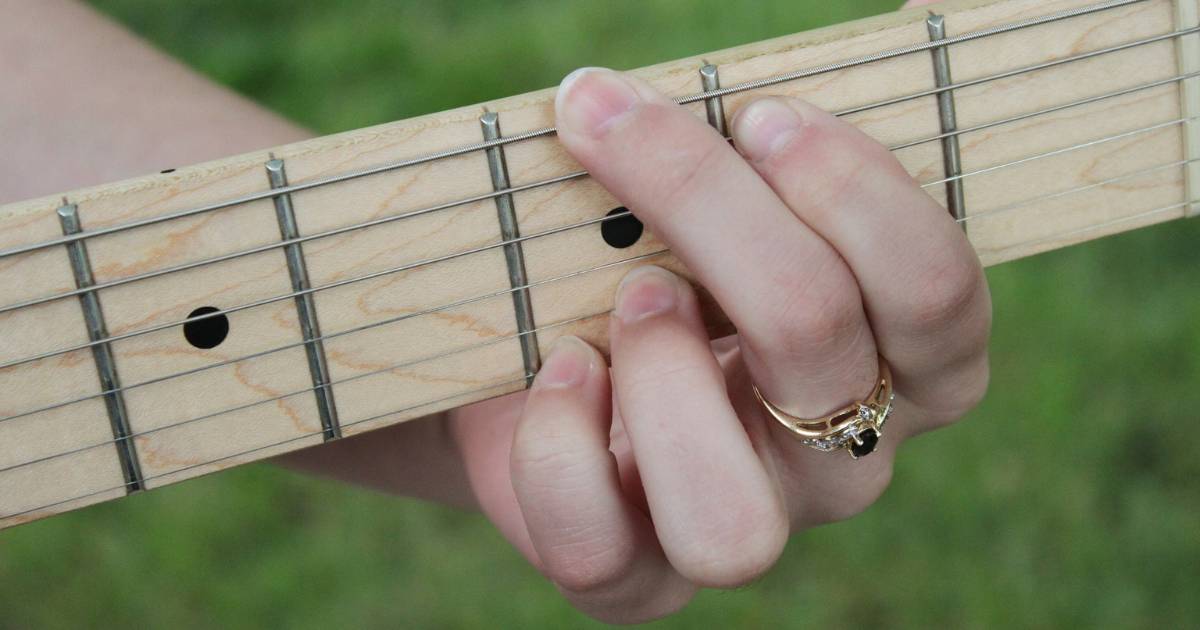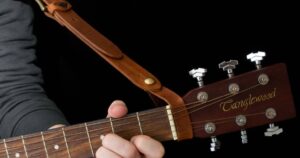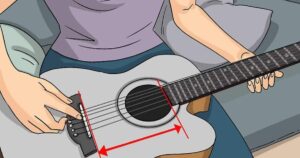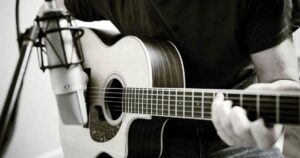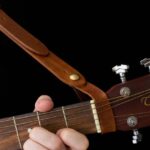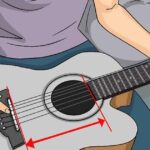Playing acoustic guitar with fingers, as opposed to using a pick, involves using one’s fingertips and nails to pluck or strum the strings. This technique, known as Play Acoustic Guitar With Fingers, allows for a different tonal quality and greater control over dynamics and expression while playing.
Imagine creating beautiful music with just your fingertips dancing on the guitar strings. Playing acoustic guitar with fingers, as opposed to using a pick, is a mesmerizing skill that can turn you into a one-person orchestra. It’s a technique that allows you to connect with your instrument on a deeper level, producing rich, soulful tones while you Play Acoustic Guitar With Fingers.
By exploring fingerpicking techniques and hand positioning, learning to play the acoustic guitar with your fingers opens up a world of intricate musical possibilities. This approach enhances your connection to the instrument and enables a wide range of styles, from gentle folk tunes to lively blues or energetic flamenco rhythms.
Getting Started
Before delving into the techniques and patterns, it’s important to ensure you have the right foundation for fingerstyle guitar playing. Here are some key aspects to consider when getting started:
Choosing the Right Guitar
Acoustic Guitar Type: While fingerstyle can be played on various acoustic guitars, the choice of guitar can affect the sound you produce. Consider the tonewood, body size, and string type that suits your playing style.
String Gauge: Lighter gauge strings are often preferred for fingerstyle playing as they are easier on the fingers and allow for more flexibility.
Nail Care
Maintaining Your Nails: Your fingernails play a crucial role in fingerstyle playing. Keep them clean and at a suitable length to ensure they don’t interfere with your technique. Many fingerstyle guitarists grow out the nails of their right-hand (picking hand) fingers slightly longer than the left-hand fingers for a more precise attack on the strings.
Fingernail Shapes: Experiment with different nail shapes, as some players prefer rounded tips, while others prefer a more flat or squared-off shape for various tonal qualities.
Fingerstyle Techniques
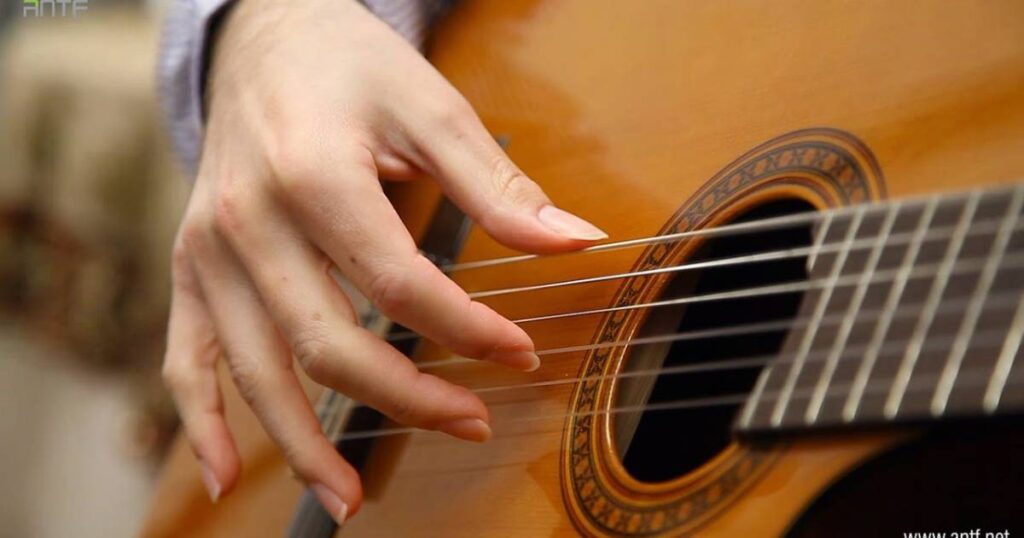
Once you have the basics in place, it’s time to explore the various techniques that form the foundation of fingerstyle guitar playing.
Thumb Technique
Thumb Position: Your thumb is primarily responsible for playing the bass notes. Position your thumb behind the neck of the guitar, allowing it to comfortably reach the low E, A, and D strings.
Alternating Bass: Practice alternating your thumb between the bass strings in a steady and rhythmic manner. This is a fundamental technique in fingerstyle playing and provides a solid rhythmic foundation for your music.
Finger Techniques
Finger Numbering: Each finger on your fretting hand is assigned a number for easy reference. Your thumb is “T,” index finger “1,” middle finger “2,” ring finger “3,” and pinky finger “4.” This numbering system helps in understanding fingerpicking patterns.
Fingerstyle Patterns: Explore various fingerpicking patterns like Travis picking, arpeggios, and classical fingerstyle. These patterns involve different combinations of finger movements to create intricate and melodious guitar parts.
Finger Independence
Individual Finger Control developing finger independence is crucial. Practice exercises that focus on controlling each finger independently, allowing you to play intricate patterns with ease.
Strength and Dexterity regular finger exercises and warm-ups help build strength and dexterity, making it easier to execute complex fingerstyle arrangements.
Hand Positioning
Proper hand positioning is essential for achieving clean and precise fingerstyle guitar playing. Here’s how to position your hands for optimal performance:
Fretting Hand
- Finger Placement: When pressing down on the strings, use the tips of your fingers, close to the frets, to minimize string buzz and ensure a clear sound.
- Hand Arch: Maintain a slight arch in your fretting hand to prevent your fingers from muting neighboring strings.
- Thumb Placement: Keep your thumb on the back of the neck, opposite your fingers. This allows for greater control and comfort when fretting chords and notes.
Picking Hand
Finger Angle: Your picking hand’s fingers should be at a slight angle to the strings, allowing for clean contact with minimal interference.
Relaxed Hand: Keep your picking hand relaxed to avoid tension that can hinder your fingerpicking speed and accuracy.
Thumb and Finger Coordination: Coordinate your thumb and fingers on the picking hand, ensuring they work together seamlessly to produce the desired sound.
Fingerpicking Patterns
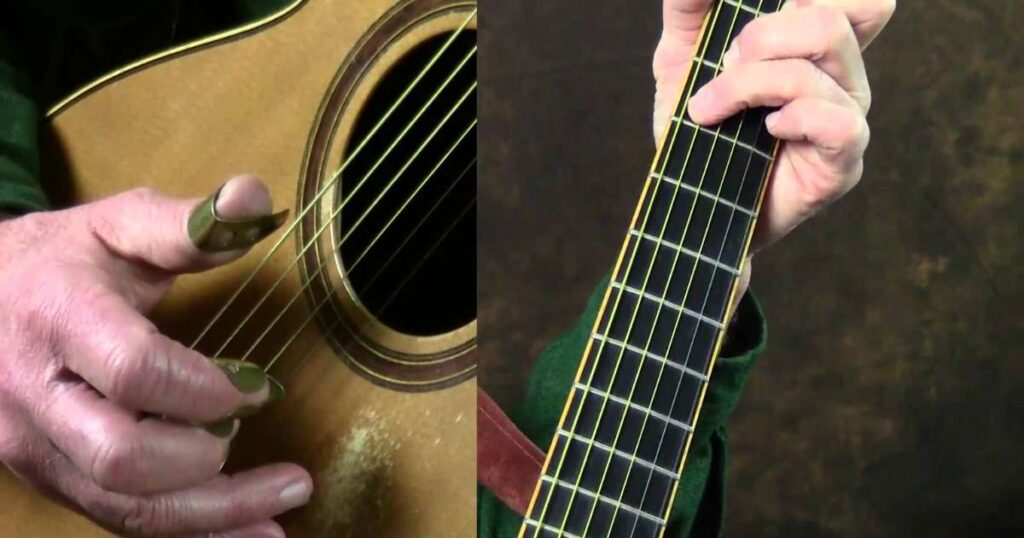
Fingerpicking patterns are at the heart of fingerstyle guitar playing. They add depth, rhythm, and melody to your music. Let’s explore some common fingerpicking patterns and how to practice them:
Travis Picking
Travis picking is a popular fingerstyle pattern named after the legendary Merle Travis. It’s characterized by a steady alternating bass line and syncopated melody. Here’s a basic Travis picking pattern:
Pattern:
- Thumb (T): Play the bass note (usually the 5th or 6th string).
- Index (1): Pluck the 3rd string.
- Thumb (T): Play the bass note again.
- Middle (2): Pluck the 1st string.
- Thumb (T): Play the bass note again.
Practice this pattern slowly until you can maintain a steady rhythm. Then, gradually increase your speed.
Arpeggios
Arpeggios involve plucking the individual notes of a chord in a specific order. This pattern is commonly used in classical and folk fingerstyle music. Here’s a simple arpeggio pattern using a C major chord:
Pattern:
- Thumb (T): Play the 5th (A) string.
- Index (1): Pluck the 3rd (G) string.
- Middle (2): Pluck the 2nd (B) string.
- Ring (3): Pluck the 1st (high E) string.
Explore different arpeggio patterns with various chord shapes to add variety to your fingerstyle playing.
Classical Fingerstyle
Classical fingerstyle patterns are known for their complexity and intricate melodies. They involve multiple fingers working together to produce beautiful and harmonious music. Here’s a basic classical fingerstyle pattern:
Pattern:
- Thumb (T): Play the 6th (low E) string.
- Index (1): Pluck the 3rd (G) string.
- Middle (2): Pluck the 2nd (B) string.
- Ring (3): Pluck the 1st (high E) string.
This pattern is just a starting point; classical fingerstyle can become incredibly intricate as you advance.
Tips for Improving Fingerstyle Playing

Improving your fingerstyle guitar playing takes time, patience, and consistent practice. Here are some tips to help you enhance your skills:
Practice Regularly
Consistency: dedicate time each day to practice fingerstyle guitar. Regular practice will help you build muscle memory and improve your finger dexterity.
Start Slow: Begin with simple patterns and gradually increase the complexity as you become more comfortable with fingerstyle playing.
Learn Songs You Love
Choose Your Favorites: Learning songs you are passionate about will keep you motivated and engaged in your practice.
Analyze Songs pay close attention to how professional guitarists use fingerstyle techniques in the songs you’re learning. This can provide valuable insights into creating your own arrangements.
Record Yourself
Recording your practice sessions allows you to listen to your progress objectively. It helps identify areas that need improvement and showcases how your playing evolves over time.Share your recordings with fellow musicians or teachers to receive constructive feedback.
Explore Different Styles
Don’t limit yourself to one style of music. Experiment with different genres, such as blues, folk, classical, and pop, to broaden your fingerstyle abilities.
Understanding music theory, chords, and scales can be immensely beneficial in creating your fingerstyle arrangements.
Study Other Fingerstyle Guitarists
Study the techniques and styles of accomplished fingerstyle guitarists like Tommy Emmanuel, Chet Atkins, and Andy McKee. Watching their performances and tutorials can be enlightening.
Attend Workshops and Take Lessons: Consider attending workshops or taking lessons with experienced fingerstyle guitarists to gain firsthand insights and guidance.
Develop Your Own Style
As you become more proficient, don’t be afraid to experiment and create your unique fingerstyle approach. This is how you develop your signature sound.
Many fingerstyle players incorporate percussion techniques, such as tapping and slapping, to add rhythmic and percussive elements to their music.
FAQ’s
How do I start playing acoustic guitar with my fingers?
To begin, practice using your fingertips to pluck the strings gently. Experiment with various fingerpicking patterns for a soft, melodic sound.
Do I need long nails to play with my fingers?
No, you don’t need long nails. Short nails or even no nails can work. Many fingerstyle guitarists prefer shorter nails for precision.
Can I play songs I like with fingerpicking?
Absolutely! Fingerstyle playing can be used for almost any song. Start with simple tunes and gradually work your way up to more complex arrangements.
Conclusion
Learning how to play acoustic guitar with your fingers is a rewarding journey that adds a touch of artistry to your music. By starting with the basics of fingerpicking and hand positioning, you can explore various styles and create your unique sound. It allows you to convey emotions and expression through the strings with a distinctive, soulful touch. Remember, you don’t need long nails; short or no nails work just fine, making it accessible to everyone.
As you progress, you can apply fingerpicking techniques to your favorite songs, adding a personal twist to your music. So, whether you’re into gentle folk melodies, lively blues, or the fiery passion of flamenco, fingerstyle playing on an acoustic guitar offers a versatile and captivating way to connect with your instrument. With patience and practice, you’ll master this art, and your guitar will become a canvas for your musical creativity, producing beautiful melodies that resonate with your heart and soul.
